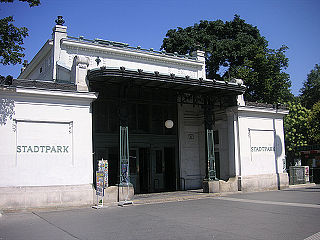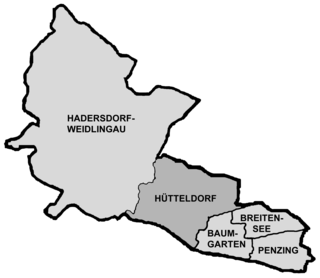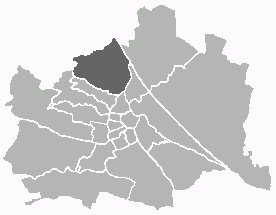| Essling | ||
|---|---|---|
| Coat of arms | SV Essling | Map |
 |  |  |
Essling [1] is part of Donaustadt, the 22nd district of Vienna.
| Essling | ||
|---|---|---|
| Coat of arms | SV Essling | Map |
 |  |  |
Essling [1] is part of Donaustadt, the 22nd district of Vienna.
The oldest form of the place name was Ezzelaren. [1] The Eslarn family had important roles in the Vienna city administration. Konrad von Eslarn was mayor of Vienna in 1287. From about 1590, the place name changed into Ehsling or Essling. The area is known for the Battle of Aspern-Essling, which was fought nearby between May 21 and May 22, 1809.
The district is also known for their own soccer-team called SV Essling, which was founded in 1931, currently playing in the minor leagues.




Landstraße is the 3rd municipal district of Vienna, Austria. It is near the center of Vienna and was established in the 19th century. Landstraße is a heavily populated urban area with many workers and residential homes. It has 89,834 inhabitants in an area of 7.42 km². It has existed since approximately 1200 AD. In 1192, the English king Richard the Lionheart was captured in the Erdberg neighbourhood, after the unsuccessful Third Crusade.

In the Battle of Aspern-Essling, Napoleon attempted a forced crossing of the Danube near Vienna, but the French and their allies were driven back by the Austrians under Archduke Charles. The battle was the first time Napoleon had been personally defeated in over a decade, but Aspern would be a sign of numerous military defeats and blunders that would soon hinder Napoleon. However, Archduke Charles failed to secure a decisive victory as Napoleon was able to successfully withdraw most of his forces.

Flak towers were large, above-ground, anti-aircraft gun blockhouse towers constructed by Nazi Germany. There were 8 flak tower complexes in the cities of Berlin (3), Hamburg (2), and Vienna (3) from 1940 onwards. Other cities that used flak towers included Stuttgart and Frankfurt. Smaller single-purpose flak towers were built at key outlying German strongpoints, such as at Angers in France, Helgoland in Germany.

The Albertina is a museum in the Innere Stadt of Vienna, Austria. It houses one of the largest and most important print rooms in the world with approximately 65,000 drawings and approximately 1 million old master prints, as well as more modern graphic works, photographs and architectural drawings. Apart from the graphics collection the museum has recently acquired on permanent loan two significant collections of Impressionist and early 20th-century art, some of which will be on permanent display. The museum also houses temporary exhibitions.

The Stadtpark in Vienna, Austria is a large municipal park that extends from the Ringstraße in the Innere Stadt first district up to the Heumarkt in the Landstraße third district. The park is divided in two sections by the Wienfluss, and has a total surface area of 65,000 square metres. Scattered throughout the park are statues of famous Viennese artists, writers, and composers, including Hans Canon, Emil Jakob Schindler, Johann Strauss II, Franz Schubert, and Anton Bruckner. The opulent Kursalon building on Johannesgasse, with its broad terrace that reaches into the park, is the site of popular waltz concerts.

The Innere Stadt is the 1st municipal District of Vienna located in the center of the Austrian capital. The Innere Stadt is the old town of Vienna. Until the city boundaries were expanded in 1850, the Innere Stadt was congruent with the city of Vienna. Traditionally it was divided into four quarters, which were designated after important town gates: Stubenviertel (northeast), Kärntner Viertel (southeast), Widmerviertel (southwest), Schottenviertel (northwest).

Hütteldorf is a part of Vienna's 14th district, Penzing. It is located in the west of Vienna, in the geographical center of the district, stretching roughly from Deutschordenstraße in the east to Wolf in der Au in the west, where Hütteldorf borders Hadersdorf-Weidlingau.

Döbling is the 19th District in the city of Vienna, Austria. It is located on the north end from the central districts, north of the districts Alsergrund and Währing. Döbling has some heavily populated urban areas with many residential buildings, and borders the Vienna Woods. It hosts some of the most expensive residential areas such as Grinzing, Sievering, Neustift am Walde and Kaasgraben and is also the site of many Heurigen restaurants. There are also some large Gemeindebauten, including Vienna's most famous, the Karl-Marx-Hof.

Donaustadt is the 22nd district of Vienna, Austria . Donaustadt is the eastern district of Vienna.

Ottakring is the 16th District in the city of Vienna, Austria. It is located west of the central districts, north of Penzing and south of Hernals. Ottakring has some heavily populated urban areas with many residential buildings. It was formed from the independent villages of Ottakring and Neulerchenfeld in 1892.

Aspern is part of Donaustadt, the 22nd district of Vienna.

The Prater is a large public park in Vienna's 2nd district. The Wurstelprater, an amusement park that is often simply called "Prater", lies in one corner of the Wiener Prater and includes the Wiener Riesenrad Ferris wheel.

The Volkstheater in Vienna was founded in 1889 by request of the citizens of Vienna, amongst them the dramatist Ludwig Anzengruber and the furniture manufacturer Thonet, in order to offer a popular counter weight to the Hofburgtheater. It was erected according to designs by Ferdinand Fellner and Hermann Helmer, who attempted to reconcile their plans with historicism. It is located in Neubau, the seventh district of Vienna.

Vindobona was a Roman military camp on the site of the modern city of Vienna in Austria. The settlement area took on a new name in the 13th century, being changed to Berghof, or now simply known as Alter Berghof.

The Donaukanal is a former arm of the river Danube, now regulated as a water channel, within the city of Vienna, Austria. It is 17.3 kilometres (10.7 mi) long and, unlike the Danube itself, it borders Vienna's city centre, Innere Stadt, where the Wien River (Wienfluss) flows into it.

The Akademietheater in Vienna, Austria, is the smaller of two performance halls of the Burgtheater organization. It was constructed in the years 1911 to 1913 by architects Fellner & Helmer and is considered today part of Austria's Federal Theatres (Bundestheater). Located on Lisztstrasse, in Vienna's third district, it is attached to its neighboring building, the Konzerthaus, a well-known performance venue for concerts.

Groß-Enzersdorf is a town and municipality in the district of Gänserndorf in the Austrian state of Lower Austria, directly to the east of Vienna and north of the river Danube. Apart from the town itself, it also comprises 7 subordinated municipalities.

The Vienna Künstlerhaus is an art exhibition building in Vienna. It is located on Karlsplatz near the Ringstraße, next to the Musikverein.
The Makrinitissa Monastery was a male Greek Orthodox monastery at Makrinitsa, near Volos, Thessaly, in central Greece.
| Wikimedia Commons has media related to Essling . |
Coordinates: 48°12′50″N16°31′30″E / 48.214°N 16.525°E